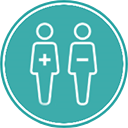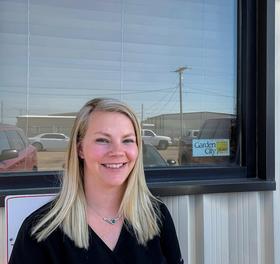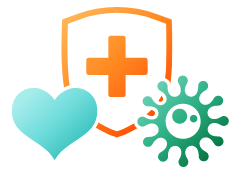Before deciding whether they’re ready to begin having sex or doing other sexual activities, it’s important for teenagers to understand the risks they will take on if they choose to start having sex. Teenagers should be well aware of the potential consequences of their actions, including raising their risk of being exposed to sexually transmitted diseases as well as, potentially, having an unintended pregnancy, but they also should know about how they can reduce or limit the risk of negative consequences of sexual activity.
In This Section
- Most Common STDs in Teens
- STD Prevention, Pregnancy & Other Issues
- Do Most Teens Have Sex?
- Do I Need to Have Sex to Have a Boyfriend or Girlfriend?
- How Can I Have Safe Sex?
- What STDs Are Teens At Risk of Contracting?
- How Can I Get Tested for STDs?
- Confidential STD Testing Services Near Me
- Are STDs Curable?
- What Should I Do If I Test Positive?
- Are Condoms the Same as Birth Control?
- Can I Get an STD Without Having Sex?
- Are STDs Dangerous?
- What the Experts Say
Most Common STDs in Teens
Sexually transmitted diseases are passed along through sexual contact, including vaginal and anal intercourse as well as oral sex and other activities. Sexually active young people are at the highest risk of contracting many common STDs, with about half of all new infections occurring in those between the ages of 15 and 24.
The most common STDs in teens include chlamydia, gonorrhea, syphilis, HPV and herpes. In many cases, infection rates for these STDs is rising among teens and adolescents, and individuals in this age group tend to have fairly high infection rates.
- Chlamydia: The rate of chlamydia in 15- to 19-year-olds rose by 7.5% between 2016 and 2017.
- Gonorrhea: The gonorrhea rate for those between 15 and 19 rose by 15.5% from 2016 to 2017, and women between 15 and 19 have the second-highest gonorrhea rate of any age group.
- Primary and secondary syphilis: Women 15 to 24 have seen an 83.3% increase in the rate of primary and secondary syphilis since 2013, while men in the same age group have seen their rate climb by 50.9% during that period.
- HPV: Human papillomavirus is by far the most common STD in the U.S., and the widespread availability of a vaccine to prevent the virus has helped decrease HPV prevalence in people between 15 and 24.
- Herpes: Genital herpes is most often caused by herpes simplex virus type 2 (HSV-2), but it’s also possible for herpes simplex virus type 1 (HSV-1), which usually affects the lips and mouth, to cause genital herpes. Generally, the rates of both types of herpes have declined in recent years.
- HIV: About 1 in 4 new cases of HIV occur in people between the ages of 13 and 24, and young men are at higher risk than young women.
STD Prevention, Pregnancy & Other Issues
The prevalence of many STDs is rising in young people despite the fact that STDs are preventable, whether through abstaining from sex or by using condoms or other safer-sex practices.
Teens who do decide to have sex should first get tested for STDs and make sure their partner does the same, and they should use male condoms, female condoms or dental dams every time they have oral, anal or vaginal sex.
Remember that the only way to guarantee you won’t get any STDs is to refrain from any kind of sexual contact, but using condoms or other protection every time you have sex and being sexually monogamous can reduce your risk of contracting STDs.
STDs are not the only potentially negative consequences from engaging in unsafe sex or even safe sex:
- Pregnancy: It may be possible to get pregnant even if the man does not ejaculate. Many women will opt for birth control as a way to prevent pregnancy, but birth control options like the pill or implantable devices do not reduce the risk of STDs, so condoms are still necessary even if you’re on birth control, especially if you or your partner have had other sexual partners or you are not currently monogamous.
- Social consequences: Young people could be at risk of social consequences like judgment from peers or conflict with family members like parents or grandparents. While many people may have had “the talk” with their parents, it’s not always common for parents and teens to discuss sex openly, and if your parents are unaware that you’re sexually active, they might react negatively when they find out.
- Legal issues: Depending on the age of your sexual partner, it’s also possible that you could be technically committing a crime by having sex if your partner is underage but you are not. These rules vary by state, so be sure you find out before you begin a sexual relationship.
Do Most Teens Have Sex?
According to the most recent data from the Centers for Disease Control and Prevention, a federal agency that reports statistics on matters of human health, just over one-third of all high-schoolers have had sexual intercourse, which is down from a high of 54% in 1991. An even smaller number, only about 28%, are currently sexually active, meaning they’d had sex within the three months before the CDC’s survey.
What this means is that no, most teenagers, at least those who are high school-age, are not having sex and haven’t ever had intercourse. It’s important to note that this data does not include things like oral or manual sex, which both can spread STDs if proper precautions aren’t taken.
However, the older the teenager, the more likely they are to have had sex; about 57% of 12th-graders in the CDC’s most recent survey reported that they had engaged in sex at some point in their lives. Still, even among that group, the majority of people were not currently sexually active.

Do I Need to Have Sex to Have a Boyfriend or Girlfriend?
No, nobody should ever pressure you into having sex or doing any other sexual activities that are against your wishes. If and when you decide you are physically and emotionally ready to have sex, that’s something you and your partner should discuss and agree on.
While sex can be a mutually beneficial and fun part of a romantic relationship, particularly for young people, the onslaught of hormones your body produces as you go through puberty can make it difficult to separate sexual urges from what you actually desire emotionally and can cloud your judgment.
Sex is not a prerequisite for love and that a person who truly loves and values you will respect your wishes. If you’ve discuss your desire to wait to have sex and your boyfriend or girlfriend still attempts to pressure you into it, it may be best to move on from that relationship.
How Can I Have Safe Sex?
There is no possible way to completely eliminate the risk of sexually transmitted diseases if you engage in any sexual contact, and you cannot totally eliminate the risk of pregnancy if you are a woman who has sex with men. The only 100% surefire method for preventing STDs or pregnancy is by not having sexual intercourse or other sexual contact.
Using condoms can reduce your risk of contracting an STD, but many STDs can be passed on through sexual contact other than intercourse. If you do decide to have sex, you and your partner should get tested beforehand; you should use a condom every time you have sex; and you should remain monogamous. Taking these precautions will ensure that neither of you, even if you are virgins, will expose the other to any STDs.
What STDs Are Teens At Risk of Contracting?
Some STDs are more common among high school-aged people than any other age groups, and the STDs most teens should be concerned with are chlamydia, gonorrhea, syphilis, HPV, herpes and HIV.
Remember that who you have sex with also can impact your risk of contracting STDs. For instance, men who have sex with men are at a higher risk of contracting certain STDs, such as syphilis and HIV.
Youth between the ages of 13 and 24 have some of the highest rates of STDs. Here’s a look at how they compare with other age groups for select STDs:
Rate of STD per 100,000 people by age group
| 13-24 | 25-34 | 35-44 | 45-54 | 55+ | |
|---|---|---|---|---|---|
| Chlamydia | 1969.4 | 963.2 | 244.7 | 75.5 | 12.2 |
| Gonorrhea | 426.6 | 355 | 131.1 | 56.4 | 10.7 |
| HIV | 67.8 | 331.2 | 466.6 | 720.8 | 339.4 |
| Primary/Secondary Syphilis | 12.5 | 23.4 | 12.8 | 9.2 | 1.9 |
In addition to many STDs being most common among young people, rates of several diseases are on the rise among the adolescent, teen and young adult populations, which means the risk of contracting STDs is on the rise for many.
How Can I Get Tested for STDs?
Several testing options are possible, though if you aren’t yet 18, it may be more difficult to get tested, depending on where you live. Despite this, if you are having sex or considering becoming sexually active, it’s important that you get tested for STDs, including HIV.
Ideally, you would speak to your mom or dad and they would take you to the doctor so you could get tested; many health insurance companies don’t charge for this type of testing or charge very little. And some healthcare providers may offer basic STD testing for free as well, so the best way to get tested is probably to involve your parents.
Lots of teens aren’t willing or able to talk to their parents about this, but even in that case, it may be possible to obtain confidential STD testing. In all states, minors can consent to receiving services for sexually transmitted infections and diseases, though in some states, doctors are permitted to inform your parents if they decide it’s necessary. Age limits do apply in some states, most often 12-14, so you should find out what’s required in your state before you get tested.
Many health clinics, such as Planned Parenthood or community health clinics, offer low-cost or free, confidential STD testing for young people. For those 18 and older, these types of clinics are also very good options, since they are generally low-cost.
If you’re unsure what’s legal in your state, you can contact a provider of low-cost and possibly free STD testing for young people. That includes places like:
- Planned Parenthood
- Community health clinics
- Urgent Care centers
- Pharmacy clinics

Confidential STD Testing Services Near Me
In most states, minors can access services for STDs, including HIV, without parental consent. Some states limit access to HIV treatment and testing as well as STD and HIV prevention without parental consent. Here’s a breakdown of age limits, service limitations and parental notification requirements.
- Healthcare provider may offer service to minor without parental consent
- If parent not immediately available, cannot be contacted or is unwilling to consent
- age 12 and older
- age 13 and older
- age 14 and older
- age 16 and older
- age 18 and older
| State | STD diagnosis and treatment | STD prevention | HIV testing | HIV treatment | HIV prevention |
|---|---|---|---|---|---|
|
Alabama
|
|
|
|
|
|
|
Alaska
|
|
|
|
|
|
|
Arizona
|
|
|
|
|
|
|
Arkansas
|
|
|
|
|
|
|
California
|
|
|
|
|
|
|
Colorado
|
|
|
|
|
|
|
Connecticut
|
|
|
|
|
|
|
Delaware
|
|
|
|
|
|
|
District of Columbia
|
|
|
|
|
|
|
Florida
|
|
|
|
|
|
|
Georgia
|
|
|
|
|
|
|
Hawaii
|
|
|
|
|
|
|
Idaho
|
|
|
|
|
|
|
Illinois
|
|
|
|
|
|
|
Indiana
|
|
|
|
|
|
|
Iowa
|
|
|
|
|
|
|
Kansas
|
|
|
|
|
|
|
Kentucky
|
|
|
|
|
|
|
Louisiana
|
|
|
|
|
|
|
Maine
|
|
|
|
|
|
|
Maryland
|
|
|
|
|
|
|
Massachusetts
|
|
|
|
|
|
|
Michigan
|
|
|
|
|
|
|
Minnesota
|
|
|
|
|
|
|
Mississippi
|
|
|
|
|
|
|
Missouri
|
|
|
|
|
|
|
Montana
|
|
|
|
|
|
|
Nebraska
|
|
|
|
|
|
|
Nevada
|
|
|
|
|
|
|
New Hampshire
|
|
|
|
|
|
|
New Jersey
|
|
|
|
|
|
|
New Mexico
|
|
|
|
|
|
|
New York
|
|
|
|
|
|
|
North Carolina
|
|
|
|
|
|
|
North Dakota
|
|
|
|
|
|
|
Ohio
|
|
|
|
|
|
|
Oklahoma
|
|
|
|
|
|
|
Oregon
|
|
|
|
|
|
|
Pennsylvania
|
|
|
|
|
|
|
Rhode Island
|
|
|
|
|
|
|
South Carolina
|
|
|
|
|
|
|
South Dakota
|
|
|
|
|
|
|
Tennessee
|
|
|
|
|
|
|
Texas
|
|
|
|
|
|
|
Utah
|
|
|
|
|
|
|
Vermont
|
|
|
|
|
|
|
Virginia
|
|
|
|
|
|
|
Washington
|
|
|
|
|
|
|
West Virginia
|
|
|
|
|
|
|
Wisconsin
|
|
|
|
|
|
|
Wyoming
|
|
|
|
|
|
Note: Entries without checks or notes does not necessarily indicate confidential testing is unavailable; many states simply don't outline rules in certain areas.
Are STDs Curable?
Many common STDs can be easily treated and cured with a pill or a shot. Chlamydia, gonorrhea and syphilis can be cured with antibiotics that can be delivered with as little as a single dose. Other STDs, like herpes, HIV and HPV, can’t be cured, but it may be possible to treat them so that you reduce outbreaks and limit long-term health consequences.
It’s important to remember that if you are getting treated for an STD, you should refrain from any sexual contact until you no longer are infected. Also, many of the rules that allow minors to get tested for STDs don’t always apply for receiving treatment, so, again, be sure you know what’s allowed in your state if it’s not possible for you to tell your parents.

What Should I Do If I Test Positive?
A positive STD test is serious, but it’s not the end of the world. As we’ve established, many STDs can be cured and others can be managed. If you have a positive STD test, the first thing to do is not have any further sexual contact with anybody until you can get treated.
Next, you must inform any sexual partners that you are infected so that they can get tested, too. The next step is getting successfully treated, which means following all of your doctor’s instructions. It’s usually recommended that you refrain from sex until you’ve had follow-up testing to ensure there’s no further infection.
Are Condoms the Same as Birth Control?
Condoms are a form of birth control, but many women who have sex with men may assume the only precautions they need to take for having safer sex is to use birth control, such as the pill or popular implantable devices like IUDs. Remember that preventing unintended pregnancy is the purpose of birth control, and to ensure you are safe from STDs, other precautions are needed.
That means using male or female condoms or dental dams every time you have sex. Also, it is possible for condoms to fail, though if used properly, they have a very high success rate.
Can I Get an STD Without Having Sex?
Yes, many STDs can be transmitted through non-intercourse sexual contact. For instance, it may be possible to contract herpes through kissing, HPV can be spread through oral sex, and an STD called trichomoniasis, or trich, can be spread through hand-to-genital contact or even contact with a sex toy.
If you are going to engage in any sexual contact, it’s best for both you and your partner to be tested so that you can take all necessary precautions to avoid transmission to the uninfected partner.
Are STDs Dangerous?
While many STDs are easily treated and some others can pass through your body without causing serious damage, a few of them can be quite dangerous, even leading to death.
- HIV The virus that causes AIDS, which is a fatal diagnosis if untreated; HIV can be successfully managed in some patients through the use of daily medications to reduce viral load, and PrEP+ can reduce the chance of infection in people who are at very high risk of HIV.
- Syphilis Untreated, this bacterial infection can spread to internal organs, including the heart and brain, causing permanent damage and even death.
- HPV By far the most common STD in the world; as many as 80% of sexually active people will contract at least one strain. Most strains are not harmful, but a few are connected with cancer, such as ovarian, anal and penile cancer. HPV vaccination is recommended for most people by age 12.
What the Experts Say
We gathered some of the best advice for teenagers (and parents) about ensuring teens are making informed, rational decisions around sex and STDs. Here’s what they had to say:

“I honestly believe that every family can be consistent with their values and expectations around teens and sex, and still have brutally honest conversations about what this data is telling us. The facts are pretty stark and kids are often smarter and savvier than we give them credit for.”
— Julianna Miner, public health professor, George Mason University

“A lot of people believe that HIV and syphilis aren’t a thing anymore, but they’re both coming back. There are different risk factors for these things, but it applies to everybody — it doesn’t just apply to men having sex with men or bisexual people or transgender people.”
— Betsy Rodriguez, Nurse, Finney County Health Department

“You can't tell if people have STDs by looking at them. So you'll want to make it clear that both of you need to get tested before you start having sex. You'll also want to be sure that your partner agrees to use condoms. Ask if your partner has ever had an STD. And if you have an STD, you'll need to tell your partner before you have sex.”
— Dr. Mary Galvin

“People don’t really know much about STIs. The thought is that you have to have symptoms, and that’s just not the case. You can still get a disease without having symptoms at the time of acquisition. A lot of this is that we need to have a much broader campaign around sexual health.”
— Dr. Peter Leone, University of North Carolina

“Teens are often self-conscious about talking about anything that has to do with their privates. But symptoms of STI shouldn't be ignored. The most common symptoms are pain with urination and unusual discharge. But any blisters or painless bumps in the private area need to be checked out as well. STIs are often pretty easy to diagnose. Normally, all that is required is an exam and a urine test.”
— Dr. Cindy Gellner

“Young women often report not knowing how to communicate with their partner and both males and females often discuss being influenced by the opinion of their peers. Learning how to communicate and negotiate either not wanting to have sex or the use of protection like condoms are some very practical skills that can help them avoid becoming infected.”
— Dafina Petrova, health researcher
Additional References
- Centers for Disease Control and Prevention, CDC Fact Sheet: Information for Teens and Young Adults: Staying Healthy and Preventing STDs. (2013.) Retrieved from https://www.cdc.gov/std/life-stages-populations/stdfact-teens.htm
- Centers for Disease Control and Prevention, STDs in Adolescents and Young Adults. (2018.) Retrieved from https://www.cdc.gov/std/stats17/adolescents.htm#ref17
- Centers for Disease Control and Prevention, High School YRBS. (2018.) Retrieved from https://nccd.cdc.gov/youthonline/App/QuestionsOrLocations.aspx?CategoryId=C04
- Parentology.com, How to Protect Your Teens From Rising STD Rates. (2019). Retrieved from https://parentology.com/how-to-protect-your-teen-from-rising-std-rates/
- High Plains Public Radio, Sexually Transmitted Diseases Rise In Kansas, Especially In Rural Counties. (2019.) Retrieved from https://www.hppr.org/post/sexually-transmitted-diseases-rise-kansas-especially-rural-counties
- TeensHealth, Talking to Your Partner About STDs. (2019.) Retrieved from https://kidshealth.org/en/teens/the-talk.html
- Well+Good, Why the Dramatic Rise in Sexually Transmitted Infections Is a Major Wakeup Call. (2019.) Retrieved from https://www.wellandgood.com/good-advice/when-to-get-sti-testing/
- University of Utah Health, Teens Are at Risk for STDs. (2018.) Retrieved from https://healthcare.utah.edu/the-scope/shows.php?shows=1_whqei36x
- Milwaukee Journal Sentinel, Living in a sexually transmitted infection hot spot: How do we protect our teens? (2018.) Retrieved from https://www.jsonline.com/story/opinion/contributors/2018/09/06/living-std-hot-spot-how-do-we-protect-milwaukees-teens/1204140002/

